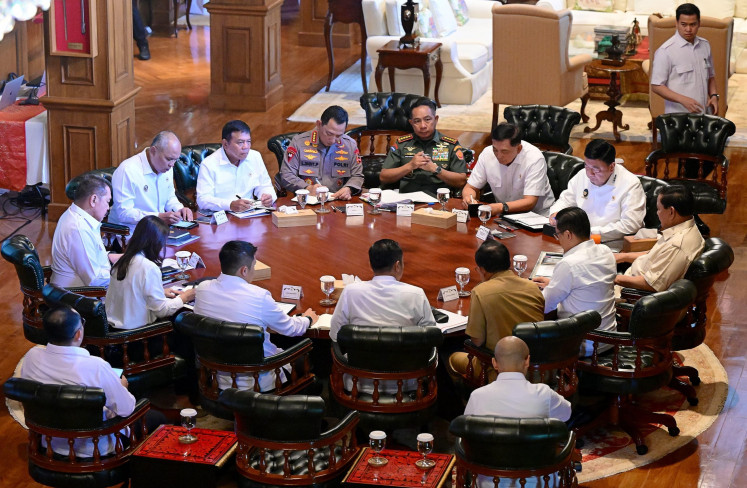Popular Reads
Top Results
Can't find what you're looking for?
View all search resultsPopular Reads
Top Results
Can't find what you're looking for?
View all search resultsJakartans squeeze into smaller, more affordable apartments
With land expensive and hard to get and house prices rising in Jakarta, accommodation issues remain a challenge with many people shifting to tiny-space living for the sake of getting a roof over their head
Change text size
Gift Premium Articles
to Anyone
W
ith land expensive and hard to get and house prices rising in Jakarta, accommodation issues remain a challenge with many people shifting to tiny-space living for the sake of getting a roof over their head.
The need for affordable living space, even if small, is seen as an opportunity with some property firms starting to develop smaller apartments, and studio units, of around 20 square meters.
Wendy Haryanto, executive director of the Jakarta Property Institute (JPI), which mediates a dialogue between the government and real-estate players, said there was a growing business to provide apartment units of smaller size.
She cited as an example the Osaka Riverview apartments — part of the 1,000-hectare Pantai Indah Kapuk 2 complex in North Jakarta owned by property giants Agung Sedayu Group and Salim Group. The apartment building, to be developed in 2022 according to its website, is offering studio-type units as small as 14 square meters, 16.5 square meters and 19 square meters.
To put this in perspective, studio apartments previously developed usually measured between 20 and 30 square meters.
"As land prices rise and regulations on building height become stricter, developers are trying to keep making money by building smaller units, which are easier to sell," she told The Jakarta Post last week.
"There are a lot of proposals from companies for development of apartment complexes with tiny units."
The potential renters for such tiny apartments are expected to be single young people or married couples without children, she added. However, the prospective buyers for the tiny apartments may not differ very much from those for the two or three-bedroom types as these properties provide an investment opportunity.
The demographic trend in the capital reflects the potential for occupants with such characteristics. Residents aged between 20 and 34 are projected to account for 26 percent, 2.7 million people, of this year's total population of 10.5 million people, data from the Statistics Indonesia's (BPS) Jakarta office shows.
Rosana, a marketer for Green Pramuka City apartment complex in East Jakarta, said her company's 21-square-meter studio-type units were usually rented by early-career workers or students at nearby campuses, while married couples bought or rented the two-bedroom units. Out of the total 45 units per floor, there are seven studio apartments.
"The studio apartment units sold faster [than the two-bedroom units] because many customers were interested in them," she said. "We are optimistic about the market outlook ahead."
The trend of students renting studio apartments is also found in Depok, West Java, a growing satellite city where various universities are located.
Yandiaz Siregar, 22, a student at a university in Depok, is living in a 27.5-square-meter studio apartment at Grand Taman Melati in Beji district near his campus.
"I chose this apartment because it provides good security," he said while also pointing out the list of amenities from living in an apartment.
The growing interest among customers in studio apartments is in line with their expected preferences for cheaper units. According to a market outlook released on Feb. 6 by online property marketplace Rumah123.com, requests for apartments costing less than Rp 300 million (US$ 21,880) were projected to account for 44.3 percent of total demand this year. However, the supply of such apartments was estimated to reach only 30.4 percent of the total apartments offered, resulting in unmet demand.
The proportion of demand for apartments costing between Rp 500 million and Rp 1 billion is expected to reach 18.2 percent, making these the second-most popular, followed by 15.5-percent demand for apartments costing between Rp 300 million and Rp 500 million.
A 14-square-meter studio unit at the Osaka Riverview apartments sells for Rp 198 million, according to its website. Meanwhile, a 21-square meter unit at the Green Pramuka City apartments costs Rp 580 million, Rosana said.
However, a lower-end of the market studio apartment in Greater Jakarta costs less than Rp 18 million per square meter on average and mid-market ones cost between Rp 18 million and Rp 35 million per square meter, 2019 data from property consulting firm Colliers International shows.
Colliers International senior associate director Ferry Salanto said the purchasing power of early-career workers might fall in that price range. However, the price of a studio apartment was expected to rise in the same way that two-bedroom or other types had risen in the past.
"There is hope for capital gain. If studio apartments become more and more expensive, this may be in line with the owner's hopes," he told the Post on Tuesday. "Despite the potential rise in prices, the cheap tiny-space apartments allow young workers to invest in something productive." (dfr)










